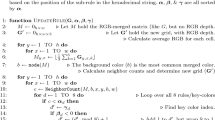Abstract
We describe an artist’s journey of working with an evolutionary algorithm to create an artwork suitable for exhibition in a gallery. Software based on the evolutionary algorithm produces animations which engage the viewer with a target image slowly emerging from a random collection of greyscale lines. The artwork consists of a grid of movies of eucalyptus tree targets. Each movie resolves with different aesthetic qualities, tempo and energy. The artist exercises creative control by choice of target and values for evolutionary and drawing parameters.
Access this chapter
Tax calculation will be finalised at checkout
Purchases are for personal use only
Preview
Unable to display preview. Download preview PDF.
Similar content being viewed by others
References
Barile, P., Ciesielski, V., Trist, K., Berry, M.: Animated Drawings Rendered by Genetic Programming. In: GECCO 2009: Proceedings of the 10th Annual Conference on Genetic and Evolutionary Computation, pp. 939–946. ACM, Montreal (2009)
Haraway, D.: Speculative Fabulations for Technoculture’s Generations: Taking Care of Unexpected Country, Essay (2007), http://www.patriciapiccinini.net (accessed 24-April-2009)
Hughes, R.: American Visions: The Epic History of Art in America. Harvill Press (1997)
Jones, L.: The Avoca Project (2009), http://www.avocaproject.org/ (accessed 24-April-2009)
Koza, J.: Genetic Programming: On the Programming of Computers by Means of Natural Selection. MIT Press, Cambridge (1992)
McCormack, J.: Evolutionary L-systems. In: Hingston, P.F., Barone, L.C., Michalewicz, Z. (eds.) Design by Evolution: Advances in Evolutionary Design, pp. 168–196. Springer, Berlin (2008)
Piccinini, P.: Signs of Life (1997), http://www.patriciapiccinini.net (accessed 24-April-2009)
Sims, K.: Artificial Evolution for Computer Graphics. In: SIGGRAPH 1991: Proceedings of the 18th Annual Conference on Computer graphics and Interactive Techniques, pp. 319–328. ACM, New York (1991)
Sims, K.: Panspermia (1990), http://www.karlsims.com/panspermia.html (accessed 27-April-2009)
Wilson, W.: Prince of Boredom: The Repetitions and Passivities of Andy Warhol (1968), http://www.warholstars.org/andywarhol/articles/william/wilson.html (accessed 24.4.2009)
Author information
Authors and Affiliations
Editor information
Editors and Affiliations
Rights and permissions
Copyright information
© 2010 ICST Institute for Computer Science, Social Informatics and Telecommunications Engineering
About this paper
Cite this paper
Trist, K., Ciesielski, V., Barile, P. (2010). Can’t See the Forest: Using an Evolutionary Algorithm to Produce an Animated Artwork. In: Huang, F., Wang, RC. (eds) Arts and Technology. ArtsIT 2009. Lecture Notes of the Institute for Computer Sciences, Social Informatics and Telecommunications Engineering, vol 30. Springer, Berlin, Heidelberg. https://doi.org/10.1007/978-3-642-11577-6_32
Download citation
DOI: https://doi.org/10.1007/978-3-642-11577-6_32
Publisher Name: Springer, Berlin, Heidelberg
Print ISBN: 978-3-642-11576-9
Online ISBN: 978-3-642-11577-6
eBook Packages: Computer ScienceComputer Science (R0)




